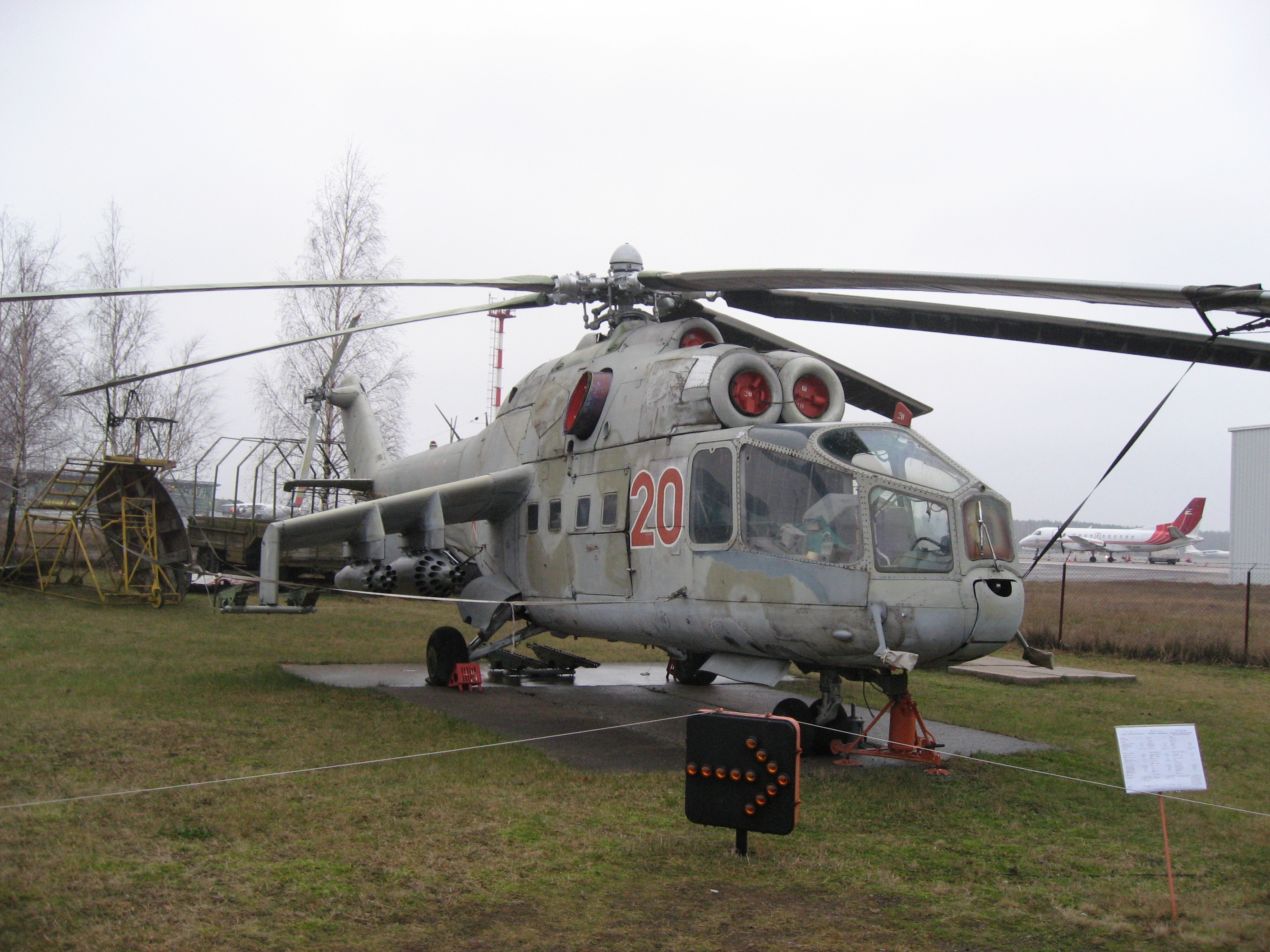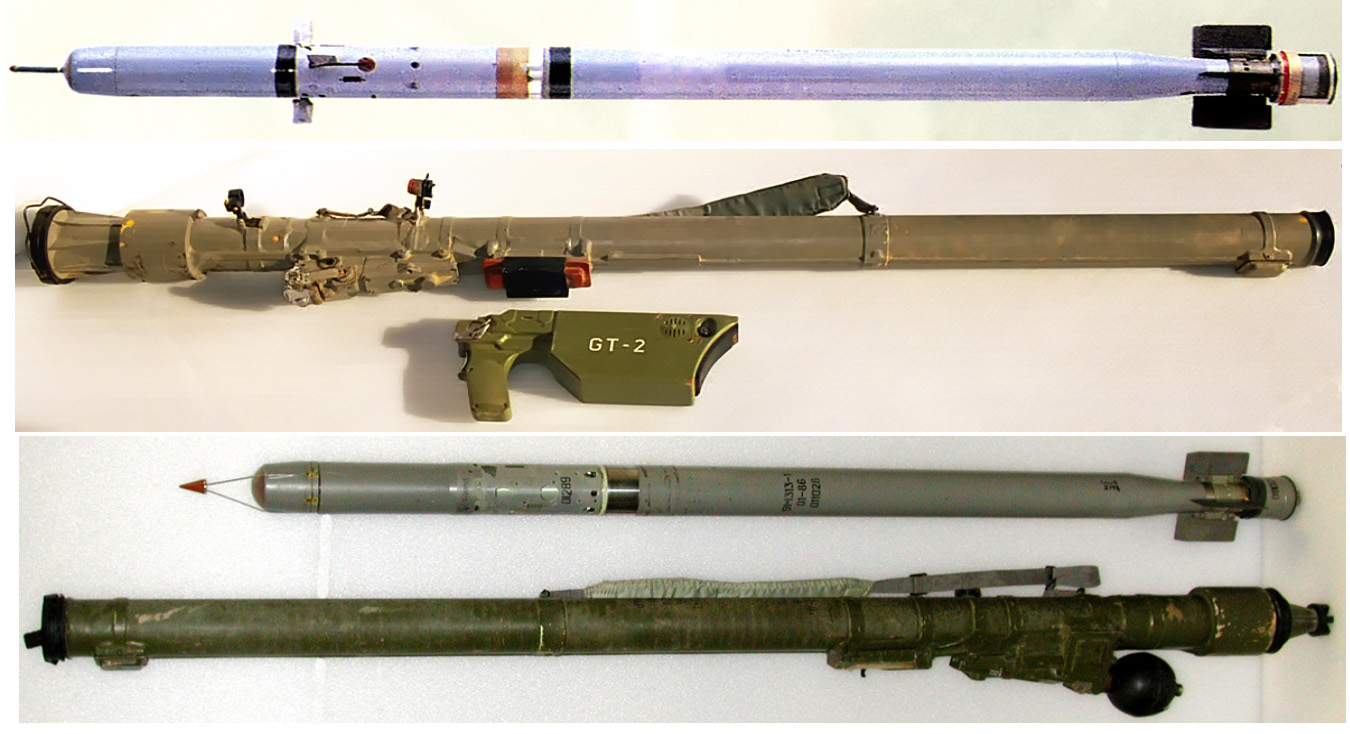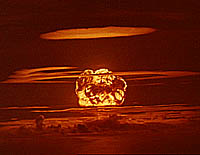|
Mi-35M
The Soviet and later Russian Mil Mi-24 helicopter has been produced in many variants, as described below. History In 1966, Soviet aircraft designer Mikhail Mil created a mock-up design of a new helicopter (derived from the Mil Mi-8) which was made with the intent of fulfilling both the role of a close air support aircraft as well as being able to transport infantry into combat. This prototype design was designated the V-24, and in 1968 a directive was given to proceed with the development of the helicopter. The Mi-24 went from the drawing board to the first test-flights in less than eighteen months, with the first models being delivered to the Soviet Armed Forces for evaluation in 1971. As a result of the speedy development, the initial Mi-24 variants had a number of problems: lateral roll, weapon sighting issues, and a limited field of view for the pilot. A later redesign of the Mi-24's front section solved most of these problems. List of variants ;A-10: Designation given to ... [...More Info...] [...Related Items...] OR: [Wikipedia] [Google] [Baidu] |
Mil Mi-24
The Mil Mi-24 (; NATO reporting name: Hind) is a large helicopter gunship, attack helicopter and low-capacity transport helicopter, troop transport with room for eight passengers. It is produced by Mil Moscow Helicopter Plant and was introduced by the Soviet Air Forces, Soviet Air Force in 1972. The helicopter is currently in use by 58 countries. In NATO circles, the export versions, Mi-25 and Mi-35, are denoted with a letter suffix as "Hind D" and "Hind E". Soviet pilots called the Mi-24 the "flying tank" (), a term used historically with the famous World War II Soviet Ilyushin Il-2#"The Flying tank", Il-2 ''Shturmovik'' armored ground attack aircraft. Other common unofficial nicknames were "Galina" (or "Galya"), "Crocodile" (), due to the helicopter's camouflage scheme, and "faceted glass, Drinking Glass" (), because of the flat glass plates that surround earlier Mi-24 variants' cockpits. Development During the early 1960s, it became apparent to Soviet designer Mikhail Mil th ... [...More Info...] [...Related Items...] OR: [Wikipedia] [Google] [Baidu] |
Gryazev-Shipunov GSh-23
The Gryazev-Shipunov GSh-23 () is a twin-barreled 23 mm autocannon developed in the Soviet Union, primarily for military aircraft use. It entered service in 1965, replacing the earlier Nudelman-Rikhter NR-23 and Rikhter R-23. The GSh-23 works on the Gast gun principle developed by German engineer Karl Gast of the Vorwerk company in 1916: it is a twin-barreled weapon in which the firing action of one barrel operates the mechanism of the other. The Gast principle provides a much faster rate of fire for lower mechanical wear than a single-barrel weapon. It cannot match the sustained rate of fire of an electrically operated multi-barrel rotary cannon such as the M61 Vulcan, but does not require an external power source, being powered by the recoil of the floating barrels, somewhat like the action of the German MG-42. The Gast principle has been little used in the West, but was used on a variety of weapons in the Soviet Union. The cannon comes in a basic GSh-23 variant, an ... [...More Info...] [...Related Items...] OR: [Wikipedia] [Google] [Baidu] |
Mil Mi-28
The Mil Mi-28 (NATO reporting name "Havoc") is a Soviet all-weather, day-night, military tandem, two-seat anti-armor attack helicopter. It is an attack helicopter with no intended secondary transport capability, and is better optimized than the Mil Mi-24 gunship for the role. It carries a single gun in an undernose barbette, plus external loads carried on pylons beneath stub wings. Development Origins In 1972, following the completion of the Mil Mi-24, development began on a unique attack helicopter with transport capability. The new design had a reduced transport capability (3 troops instead of 8) and omitted the cabin to provide better overall performance and higher top speed. Improved performance was important for its intended role fighting against tanks and enemy helicopters and covering helicopter landing operations. Initially, many different designs were considered, including an unconventional project with two main rotors, placed with engines on tips of wings (in perp ... [...More Info...] [...Related Items...] OR: [Wikipedia] [Google] [Baidu] |
Mil Mi-24 Early Series Comparison Line Drawing
Mil, mil, or MIL may refer to: Places * Mil, Syria, a village in Syria * Mil, Azerbaijan, a municipality in Beylagan Rayon * Mil, Markazi, a village in Markazi Province, Iran * Metropolitan area of Milan (List of airports by IATA code: M, IATA code: MIL), Italy (Milan is city in Italy) * Mill Hill Broadway railway station (National Rail station code: MIL), England * Miltenberg (district), (German vehicle registration code: MIL) * A common abbreviation for the U.S. city of Milwaukee, Milwaukee, Wisconsin and its major professional sports teams: ** Milwaukee Brewers, the city's Major League Baseball team ** Milwaukee Bucks, the city's National Basketball Association team Business and organizations * Marine Industries Limited, a Canadian shipbuilder * Microsystems International Limited, a former Canadian semiconductor device manufacturer * Mil Moscow Helicopter Plant, a Russian helicopter manufacturer * ''Movimiento Ibérico de Liberación'' (Iberian Liberation Movement), a Catala ... [...More Info...] [...Related Items...] OR: [Wikipedia] [Google] [Baidu] |
FLIR
Forward-looking infrared (FLIR) cameras, typically used on military and civilian aircraft, use a thermographic camera that senses infrared radiation. The sensors installed in forward-looking infrared cameras, as well as those of other thermal imaging cameras, use detection of infrared radiation, typically emitted from a heat source (thermal radiation), to create an image assembled for video output. They can be used to help pilots and drivers steer their vehicles at night and in fog, or to detect warm objects against a cooler background. The wavelength of infrared that thermal imaging cameras detect is 3 to 12 μm and differs significantly from that of night vision, which operates in the visible light and near-infrared ranges (0.4 to 1.0 μm). Design Infrared light falls into two basic ranges: ''long-wave'' and ''medium-wave''. Long-wave infrared (LWIR) cameras, sometimes called "far-infrared", operate at 8 to 12 μm and can see heat sources, such as hot eng ... [...More Info...] [...Related Items...] OR: [Wikipedia] [Google] [Baidu] |
Air-to-air Missile
An air-to-air missile (AAM) is a missile fired from an aircraft for the purpose of destroying another aircraft (including unmanned aircraft such as cruise missiles). AAMs are typically powered by one or more rocket motors, usually solid-fuel rocket, solid fueled but sometimes liquid-fuel rocket, liquid fueled. Ramjet engines, as used on the Meteor (missile), Meteor, are emerging as propulsion that will enable future medium- to long-range missiles to maintain higher average speed across their engagement envelope. Air-to-air missiles are broadly put in two groups. Those designed to engage opposing aircraft at ranges of around 30 km to 40 km maximum are known as short-range or "within visual range" missiles (SRAAMs or WVRAAMs) and are sometimes called "dogfight" missiles because they are designed to optimize their agility rather than range. Most use infrared guidance and are called heat-seeking missiles. In contrast, medium- or long-range missiles (MRAAMs or LRAAMs), which ... [...More Info...] [...Related Items...] OR: [Wikipedia] [Google] [Baidu] |
9K38 Igla
The 9K38 Igla (, "needle", NATO reporting name SA-18 Grouse) is a Soviet/Russian man-portable infrared homing surface-to-air missile (SAM) system. A simplified, earlier version is known as the 9K310 Igla-1 (NATO: SA-16 Gimlet), and the latest variant is the 9K338 Igla-S (SA-24 Grinch). The Igla-1 entered service in 1981, the Igla in 1983, and the Igla-S in 2004. The Igla has been supplemented by the 9K333 Verba since 2014.New Russian Verba MANPADS will replace Igla-S - Armyrecognition.com, 15 September 2014 History The development of the Igla short-range man-portable air defense system ( |
ATGM
An anti-tank guided missile (ATGM), anti-tank missile, anti-tank guided weapon (ATGW) or anti-armor guided weapon is a guided missile primarily designed to hit and destroy heavily armored military vehicles. ATGMs range in size from shoulder-launched weapons, which can be transported by a single soldier, to larger tripod-mounted weapons, which require a squad or team to transport and fire, to vehicle and aircraft mounted missile systems. Earlier man-portable anti-tank weapons, like anti-tank rifles and magnetic anti-tank mines, generally had very short range, sometimes on the order of metres or tens of metres. Rocket-propelled high-explosive anti-tank (HEAT) systems appeared in World War II and extended range to the order of hundreds of metres, but accuracy was low and hitting targets at these ranges was largely a matter of luck. It was the combination of rocket propulsion and remote wire guidance that made the ATGM much more effective than these earlier weapons, and gave ... [...More Info...] [...Related Items...] OR: [Wikipedia] [Google] [Baidu] |
Shturm
9K114 ''Shturm'' – Weaponsystems.net () – is a radio guided system of the . Its designation is 9K114. Its is AT-6 ''Spiral''. The missile itself is kno ... [...More Info...] [...Related Items...] OR: [Wikipedia] [Google] [Baidu] |
9M120 Ataka
The 9M120 ''Ataka'' (; ''Attack'') is an anti-tank guided missile (ATGM) originating from the Soviet Union. The NATO reporting name of the 9M120 missile is the AT-9 ''Spiral-2''. It is the next major generation in the 9K114 Shturm (AT-6 Spiral) family. The missile has radio command guidance and is also a beam riding SACLOS. This missile's primary variant was designed to defeat tanks with composite armour and explosive reactive armor. The 9M120 Ataka system is often confused with the 9K121 Vikhr system, despite being different weapons systems developed by different companies. The former was designed by the KBM machine-building design bureau and manufactured by the Degtyarev plant. According to the Stockholm International Peace Research Institute, Russia exported the Ataka ATGM to Iran, Kazakhstan, and Slovenia. Development The 9M120 missile was developed by the Kolomna engineering design bureau, located in Kolomna. This company already designed previous ATGMs, such as the 9M14 Ma ... [...More Info...] [...Related Items...] OR: [Wikipedia] [Google] [Baidu] |
Chernobyl Disaster
On 26 April 1986, the no. 4 reactor of the Chernobyl Nuclear Power Plant, located near Pripyat, Ukrainian Soviet Socialist Republic, Ukrainian SSR, Soviet Union (now Ukraine), exploded. With dozens of direct casualties, it is one of only two nuclear energy accidents rated at the maximum severity on the International Nuclear Event Scale, the other being the 2011 Fukushima nuclear accident. The response involved more than Chernobyl liquidators, 500,000 personnel and cost an estimated 18billion Soviet ruble, rubles (about $84.5billion USD in 2025). It remains the worst nuclear disaster and the List of disasters by cost, most expensive disaster in history, with an estimated cost of US$700 billion. The disaster occurred while running a test to simulate cooling the reactor during an accident in blackout conditions. The operators carried out the test despite an accidental drop in reactor power, and due to a design issue, attempting to shut down the reactor in those conditio ... [...More Info...] [...Related Items...] OR: [Wikipedia] [Google] [Baidu] |
Weapons Of Mass Destruction
A weapon of mass destruction (WMD) is a Biological agent, biological, chemical weapon, chemical, Radiological weapon, radiological, nuclear weapon, nuclear, or any other weapon that can kill or significantly harm many people or cause great damage to Artificiality, artificial structures (e.g., buildings), Nature, natural structures (e.g., Mountain, mountains), or the biosphere. The scope and usage of the term has evolved and been disputed, often signifying more politically than technically. Originally coined in reference to strategic bombing, aerial bombing with Explosive material#Chemical, chemical explosives during World War II, it has later come to refer to large-scale weaponry of warfare-related technologies, such as Biological warfare, biological, chemical warfare, chemical, Radiological warfare, radiological, or nuclear warfare. Early usage The first use of the term "weapon of mass destruction" on record is by Cosmo Gordon Lang, Archbishop of Canterbury, in 1937 in refere ... [...More Info...] [...Related Items...] OR: [Wikipedia] [Google] [Baidu] |








